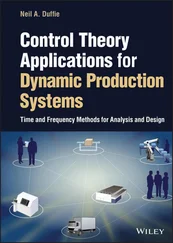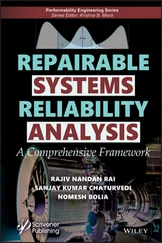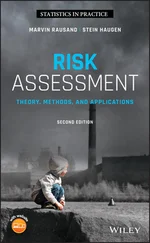1 Definition 3.1is mainly a rephrasing of IEV's definition of a failure: “loss of ability to perform as required” (IEV 192‐03‐01), but the expression “loss of ” is replaced with the expression “the termination of” to make it even more clear that a failure is an event that takes place at a certain point in time (e.g. at time ).
2 In the context of reliability, the expression “ability to perform as required” does not imply that all aspects of the item are perfect, but that the item must be able to perform the functions that are required for a given purpose.
3 The item may deteriorate as a slow process. Failure occurs when a required function no longer fulfills its performance requirements, and it may not be any significant change in performance when the threshold is passed, as shown in Example 3.2.
4 One user may interpret “as required” different from another user. A failure that is important (and costly) in a warranty context may, for example, be irrelevant in a risk assessment context.The performance requirements for an item are usually available in the item specification document and partly in the user's manuals, but users seldom read the specifications and the complete user's manual.
5 We use the verb fail to express that a failure occurs. When a failure occurs at time , the item fails at time .
A failure may be interpreted as a transition from a functioning state to a failed state , as shown in Figure 3.2. Example 3.2illustrates that we may not always be able to observe the failure event and the time  of the failure.
of the failure.
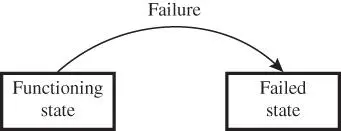
Figure 3.2Failure as a transition from a functioning state to a failed state.
When a car is used, the tires wear and the tire tread depth is continuously reduced and thereby the performance of the tires is degrading. When the depth becomes smaller than a certain legal limit  (may be different in the different countries), the tires have to be replaced. A failure occurs when the tread depth passes
(may be different in the different countries), the tires have to be replaced. A failure occurs when the tread depth passes  . In this case, it is not possible to determine exactly the time of failure, and there is no dramatic change of performance when the failure occurs, but the risk of water planning and of puncture is considered to be unacceptable with a smaller depth than
. In this case, it is not possible to determine exactly the time of failure, and there is no dramatic change of performance when the failure occurs, but the risk of water planning and of puncture is considered to be unacceptable with a smaller depth than  .
.
3.2.1 Failures in a State
It is sometimes useful to distinguish between failures that occur in a state from failures that occur during a transition. The types of failures occurring in a state are illustrated in Examples 3.3, 3.4, and 3.5.
Consider an electric driven water pump. The essential function of the pump is to pump water at a certain rate. Assume that the target rate is 100 l/min, with performance criterion saying that the rate need to be between 95 and 105 l/min. In case of internal fouling, the pumping rate may decrease such that the performance criterion is no longer met. When the rate passes the lower threshold rate, a pump failure occurs and the pump has to be stopped. The pump remains in this state until it has been cleaned/repaired. This process is illustrated in Figure 3.3.
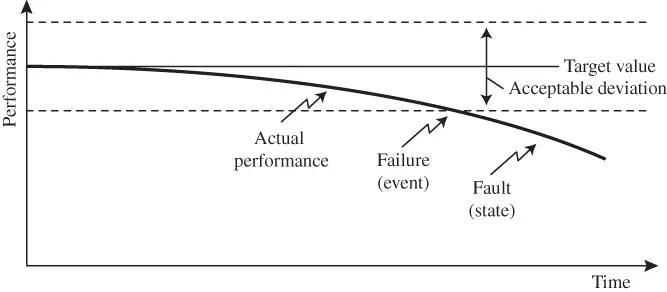
Figure 3.3Illustration of the difference between failure and fault for a degrading item.
Example 3.4 (Light bulb–continuously “on”)
Consider a light bulb that is always switched on. The function of the bulb is to provide light. When the light bulb fails, the failure occurs in an operating state. If someone is present and can observe the loss of light event, the precise time of the failure can be recorded.
Example 3.5 (Light bulb–“on” only on demand)
Reconsider a light bulb, similar to the one in Example 3.4, but assume that the light bulb is very seldom switched on and that it each time is energized for a short time period. The bulb may also fail in passive state (e.g. due to vibrations). A failure in passive state is not observable and leaves a hidden fault . The hidden fault is not revealed until the light bulb is switched on next time. The time  of the occurrence of the failure is unknown. When we try to switch on the light and observe that it has failed, we only know that the failure occurred in the time interval since the preceding use of the light bulb. (In this example, we assume that the switch is functioning without failure.)
of the occurrence of the failure is unknown. When we try to switch on the light and observe that it has failed, we only know that the failure occurred in the time interval since the preceding use of the light bulb. (In this example, we assume that the switch is functioning without failure.)
3.2.2 Failures During Transition
A failure during transition may either be caused by an existing hidden fault or an erroneously performed transition, as illustrated in Examples 3.6and 3.7.
Consider a lawn mower with a petrol engine that is started by pulling a rope. To start the lawn mower involves a transition from a passive to an active state of the mower. A failure during this transition may be caused by an internal defect (e.g. corrosion, or contaminated petrol), but may also be due to incorrect starting procedure.
Example 3.7 (Safety valve)
Reconsider the safety valve in Example 3.1and assume that the valve is in fully open state when an emergency occurs on the downstream side of the valve. The valve receives a signal to close and the transition is initiated. Due to debris in the valve cavity, the movement is stopped before the valve reaches the closed state.
The term fault is mentioned in Section 3.2, but without a proper definition. We define a fault as:
Definition 3.2 (Fault of an item)
A state of an item, where the item is not able to perform as required.
The duration of the fault may range from negligible to permanent. There are two main types of faults.
Type 1 fault is a fault that occurs as a consequence of a failure. The failure causes a transition from a functioning state into a fault, which is also called a failed state. In Example 3.4, the failure of the light bulb left the bulb in a state where it cannot give light. In this example, the bulb has to be replaced to function again.
Type 2 fault is a fault that is introduced in the item due to human error or misjudgment in the specification, design, manufacture, transportation, installation, operation, or maintenance of the item. This type of fault enters the item without any preceding item failure and is a dormant fault that remains hidden until the item is activated or inspected. A type 2 fault is also called a systematic fault. A software bug is a typical example of such a fault. Another example is faults caused by design errors or installation errors.
Читать дальше
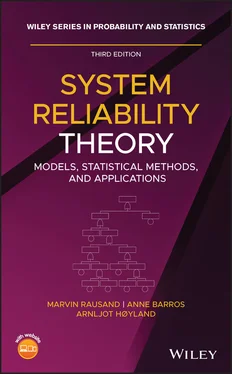
 of the failure.
of the failure.
 (may be different in the different countries), the tires have to be replaced. A failure occurs when the tread depth passes
(may be different in the different countries), the tires have to be replaced. A failure occurs when the tread depth passes  . In this case, it is not possible to determine exactly the time of failure, and there is no dramatic change of performance when the failure occurs, but the risk of water planning and of puncture is considered to be unacceptable with a smaller depth than
. In this case, it is not possible to determine exactly the time of failure, and there is no dramatic change of performance when the failure occurs, but the risk of water planning and of puncture is considered to be unacceptable with a smaller depth than  .
.
 of the occurrence of the failure is unknown. When we try to switch on the light and observe that it has failed, we only know that the failure occurred in the time interval since the preceding use of the light bulb. (In this example, we assume that the switch is functioning without failure.)
of the occurrence of the failure is unknown. When we try to switch on the light and observe that it has failed, we only know that the failure occurred in the time interval since the preceding use of the light bulb. (In this example, we assume that the switch is functioning without failure.)


